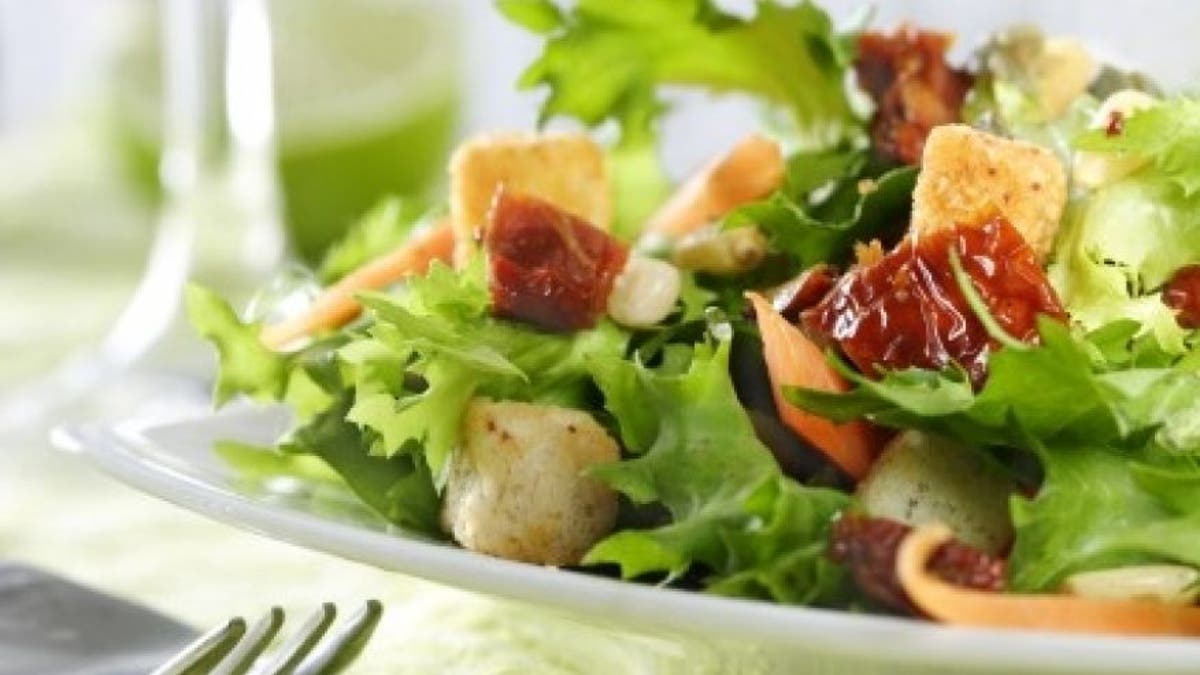
(iStock)
Salads are a dieter’s best friend. But that does not mean they have to be boring piles of lettuce. If done right they can be delicious, filling and nutritious. Also, many salads can cost you more calories than a cheeseburger, so beware!
Use the tips below to build a salad that will be both delicious and good for your waistline.
1. Start with a dark, leafy bed of greens – Ditch the nutrient-less iceberg lettuce and choose dark leafy greens that offer more vitamins, minerals, and fiber. Get the widest variety of nutrients by mixing different greens like spinach, kale, swiss chard, watercress and romaine. A 2 cup serving of kale, swiss chard, and watercress will provide you with your daily requirement for vitamin A, C, and K and give you a boost of phytonutrients that help reduce your risk factors for certain cancers.
2. Make it pop with colorful non-starchy veggies –Jazz up your salad with a slew of nutrient dense and delicious vegetables like beets, tomatoes, carrots, asparagus, Brussels sprouts, radishes, red peppers, red cabbage and cauliflower. Mix colors and textures to make for an interesting and healthy bite! Brussels sprouts can be added to a salad cooked or raw, and give you 4 grams of fiber per cup! Shredded carrots add a great texture, give you 4 grams of fiber per cup, and are packed with vitamin A, C and beta-carotene, a powerful antioxidant.
3. Top with a lean protein – Make your salad a filling and complete meal by topping it with a lean protein. Choose proteins such as grilled chicken breast, shrimp, tuna, steak trimmed of fat or low-fat cottage cheese. The combination of the fiber from the veggies and protein will give you sustained energy throughout the day and keep you feeling full. Men should aim for a 6-ounce serving of protein and women for a 3-ounce serving. Avoid calorie dense proteins such as full-fat cheeses and bacon to keep your lunchtime meal waistline friendly.
4. Hate lettuce? Make a lettuce-less salad – If lettuce isn’t your thing there is no reason you can’t still enjoy a healthy salad. Lettuce-less salads made just of non-starchy veggies and protein still make for a great meal. Try using julienne cabbage as your base to make a play on a slaw. Another option is a traditional Greek salad, which is made with large cut cucumbers, tomatoes, onions, capers, and topped with low-fat feta and lemon juice. You can also make a cauliflower “cous cous” salad by grating raw cauliflower to a fluffy crunchy bed for your favorite non starchy veggies.
5. Don’t make your salad a calorie bomb - Dressings and toppings on a salad is a common pit fall for dieters. Many dressings can transform a seemingly healthy salad into a calorie bomb! Avoid this trap by always getting dressings on the side. A good trick is dipping your fork first in the dressing then in the salad. Another option is making a low calorie alternative by using balsamic or red wine vinegar mixed with some Dijon mustard. Also, beware of salad toppings like nuts, avocado, dried fruit, corn, grains, and beans. Even though they can be healthy, they can also add a lot of additional calories and carbohydrates. Case in point: A ¼ cup serving of craisins packs 130 calories and has the same amount of carbohydrates as 2 slices of bread! So choose one fun topping and stick to a serving, while filling your bowl with mostly non-starchy veggies!
As you can see above, there are many ways to enjoy healthy, delicious, and nutritious salads. Get creative with your salads and explore new flavors each time. With all the health benefits, your body will thank you!




















